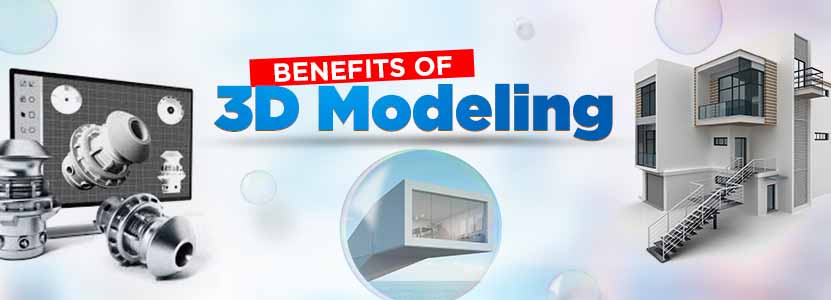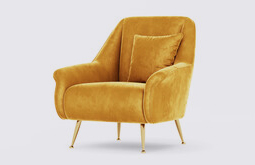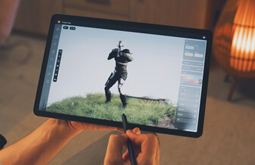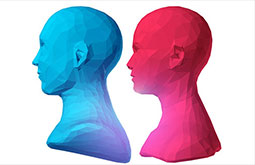How 3D Modeling Transforms Businesses in Different Sectors
3D modeling has found profound use in the modern-day business landscape and is widely used across a number of industries to visualize products and processes, to secure funding for new research projects, to pitch ideas to clients, to create novel products and to make the most out of marketing and advertising campaigns. 3D modeling allows people to gain a clearer understanding of products and processes and this way, it allows people to evaluate designs and to find out errors before the actual products or processes are given a real shape. 3D modeling brings ideas into life, thereby allowing businesses to test if their ideas would sell in the long run in a more practical manner.
Before we dig deeper into the advantages of three dimensional (3D) modeling, let us look through an overview of how it impacts different industries:

Use in Mechanical Engineering
3D CAD modeling is used in the field of mechanical engineering to facilitate a better visualization of designs, easy documentation, compliance to global standards, improvisation of design quality, automatic redrawing of designs, and enhancement of the designer’s productivity. Mechanical engineering design is a complex field that demands precision, detailing, and knowledge of the design professionals. 3D models are formed on the basis of accurate measurements and they can be tweaked easily if revisions are required. This makes 3D mechanical engineering models accurate, which, in turn, promotes the creation of flawless machinery that can be used by businesses in various industries and by scientific institutions alike.
-
Marketing and Advertising
3D modeling has found widespread use in the marketing and advertising industries. Marketers can create stunning product visuals by using a harmonious combination of 3d modeling and animation. 3D models, which portray every finer aspect of a product in greater detail, make marketing collateral effective marketing tools with strong impacts. 3D visuals create a long lasting impact in the minds of people, thereby allowing them to relate to a product or a service in a deeper way. 3D modeling can be successfully used to promote a company’s branding efforts and to create a strong brand identity in the market.
-
Automobile
3D automobile modeling is commonly used by automobile manufacturers across the globe to evaluate design efficacy, to test initial market response, and also to promote their products through different marketing campaigns. 3D models of automobiles allow engineers, design experts, and businesses to evaluate new designs and to identify and rectify errors. This leads to the creation of efficient automobiles that can address the customers’ unique needs.
-
Gaming
The realistic appeal of modern-day video games owes their origin to the extensive use of 3D modeling in the gaming industry. 3D modeling is used to create unique life-like characters and to instill vibrant effects in a game. With 3D modeling, it is possible to create lively environments, scenes, and realistic game props. Game developers have been making use of 3D game characters and 3D environments to create realistic, immersive environments that can generate awesome gaming experience, allowing players to relate to the characters and the settings.
-
Entertainment
3D modeling is used in most movies to instill special effects. 3D modeling is applied to describe supernatural events in a very exciting manner. 3D modeling generates realistic and immersive effects that can elevate viewers’ experience to a new level. As the entertainment industry continues to become more and more modernized, 3D modeling will assume a more advanced makeover and would be used to generate stunning effects.
-
Healthcare
3D modeling is used in the healthcare industry to design medical equipment such as stethoscope, prosthetics, thermometer, syringe, blood pressure machine, etc. 3D models of anatomy and processes are also used to train medical staff. 3D modeling is associated with benefits such as precision and detail. The designing of medical equipment is based on accurate measurements and an attention-to-detail approach and this is the reason why it is widely deployed in the manufacturing of medical equipment.
-
Publishing
Publishers are making use of a 3D modeling to enliven photographs that are used in textbooks, guidebooks, or books that contain a lot of illustrations. By incorporating 3D graphics, publishers are able to explain complex concepts in an easy manner, thereby promoting readability and a better learning experience. Scientific books that feature complex data commonly feature 3D graphics that explain complex concepts in greater detail.
-
Manufacturing
Manufacturing companies make use of 3D modeling to test product designs so that they can detect flaws before the manufacturing process starts. Using 3D modeling, they can also design manufacturing processes, thereby allowing the manufacturing teams to understand the intricacies and steps involved. Realistic 3D product models allow stakeholders to get a detailed understanding of product features and to modify them as per predefined parameters.
-
Architecture & Construction
Realistic 3D models allow architects, the construction team, and prospects to understand project scope well, which results in fewer surprises as the project progresses. Additionally, architects can manipulate 3D models in their preferred ways, which they cannot do with 2D drawings. They can also verify various options in the 3D scale to identify potential scenarios. This would help them to take the right steps and eliminate errors in the early stages. 3D models, a design team can gain a proper understanding of how a change in one aspect can affect the other aspects. A building project remains in a selling process in all its stages. Major decisions revolve around the choice of architectural designs and development-related options. Prospective clients need to be kept updated about these aspects so that they remain engaged throughout the process, which in turn would promote positive sales outcomes. A detailed and realistic model of a real estate property is a crucial marketing tool that real estate businesses can use to attract prospective clients and to show them how a finished product would look like. Real estate businesses can use gorgeous and detailed 3D walkthroughs to market their properties to potential clients. Prospects find 3D real estate models to be compelling and they are more likely to feel get an immersive experience with 3D imagery compared to the level of attachment that they would have with 2D drawings. Vivid imagery creates a deep impact on the people’s mind, which may ultimately result in sales.
Impact of 3D modeling on projects across industries
- Allows for detailed project visualization:
An image speaks a thousand words. 3D models allow for detailed 3D visualization of projects. Human beings are able to easily grasp spatial concepts if they are allowed to see them. Research reveals that 90 percent of the information that is transferred in the human brain is visual.
-
Accelerates project speed
3D models allow all participants to have a clear understanding of all aspects of the project. 3D models can be used effectively to explain the project plan properly to stakeholders. This leads to a smoother work flow and a more efficient designing process. With 3D modeling, it is much easier to build structures to showcase product details. This saves money and time, which can be used to promote other aspects of the project.
-
Promotes Precision and control
3D models are built based on data, which is what leads to an accurate representation of a product. With 3D modeling, it is possible to create realistic models of products and processes. 3D modeling makes designs come to life and allows stakeholders to get a detailed view of a product. Professionals can also evaluate design feasibility and determine how changes would impact the overall design.
-
Helps in securing license
By using a 3D model to represent an upcoming product design, businesses can easily obtain the required permits for their new projects. Securing proper permits is vital to ensuring project execution and completion without any legal issues. This barrier can be successfully overcome by using 3D models. The 3D model will allow regulators to evaluate the design. 3D models provide better clarity, thereby allowing regulators to make decisions faster.
-
Circumvents language barriers
With 2D drawings, the manufacturing team would need to get a lot of instructions from the planning or designing team in order to be able to interpret design information. Language barriers may further make this situation more complicated. On the other hand, 3D designs, with their clarity and detail, eliminate the need for delivering instructions and prevents language barriers from jeopardizing project flow. 3D designs create a feel of virtual reality, thereby allowing stakeholders to gain a deeper understanding of a project’s design aspects.
-
Leads to successful project execution
Clear, detailed designs allow production teams to execute and complete projects as per plan and by using lesser monetary resources. 3D modeling has been found to be associated with positive project implementation outcomes including lesser possibilities for rework, enhanced productivity, eradication of field interferences, improvement in productivity, fewer change requests, fewer information requests, cost-effectiveness and cost-control, and faster facility turnover.
-
Facilitates accurate measurements
3D designs are widely used in the architecture and interior designing industries. A 3D design clearly depicts the physical dimensions of objects and their relative distances with other objects in a layout. 3D models allow customers to see and adjust object- arrangements in their preferred ways so as to make changes to the plan to address issues concerning movement, space, room size, etc.
-
Benefits interior designers
Interior designers can use 3D modeling to portray their project plans through virtual staging. They can bring their designs to life by complementing the indoor spaces of commercial or residential properties with virtual furniture, show pieces, wall paints, and designer ceilings. This allows them to win the confidence of their prospective clients and to close deals.
Conclusion
3D models allow for a strong, realistic visualization. 3D modeling promotes planning and designing efficiencies and allows for easy implementation of changes and rectification of errors. However, it is always recommended to hire a professional 3D design services provider for any 3D modeling services requirements, considering their vast experience and domain expertise. These agencies are backed by immensely skilled and professionally trained 3D experts. They can deliver the best-in-class visualization solutions such as interior 3D modeling, 3D exterior modeling, etc."




